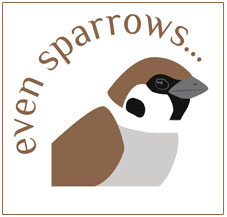

OWLS OVERWINTERING ON HOLY ISLAND
Posted: 01.01.24 in Articles category
Last winter was a good year for Short-eared Owls overwintering on Holy Island. Resident bird expert Ian Kerr wrote a detailed article for the village E-newsletter back in February and I saved it at the time with the view of sharing it with followers of Even Sparrows.
It has been a great winter on the island for Short-eared Owls which have been patiently quartering the rougher fields and dunes in a never-ending hunt for their favoured prey, voles. They're the most obvious of owls simply because of their habit of hunting during daytime. Most of our other owls are largely nocturnal although the island's resident Barn Owls seem increasingly to appear by day. For example, on a bright and sunny New Year's Day I watched one drifting slowly from the Heugh and then low through the Vicarage garden.
But back to our Short-eared Owls. At one stage over the winter I reckon there were up to ten on the island. Up to four were regularly hunting the fields between the north end of the Straight Lonnen and the Lough, one was around the Rocket Field and Crooked Lonnen and yet another in the dunes between Sandham Bay and Snipe Point. Others were regularly on the Snook. With their smart brown plumage, long wings and glaring yellow eyes, these owls are always a joy to watch, particularly as it's often possible to get close to them. They're quite fearless or perhaps just largely oblivious of human presence, often flying within a few feet. The owls hunt by slowly and systematically quartering low over the fields, heads bend downwards in searching, before making sudden plunges into the tussocks. Usually, they rise immediately and flap on, a sign of they missed their fleeting target or that nothing was there in the first place. When they stay on the ground for a few minutes it's normally because they've been successful and are swallowing their prey whole, as most owls do. When not hunting, the 'Shorties' are normally resting concealed by thick ground cover or simply using the stone walls and fence lines as handy resting places.
During winter they seem solitary creatures. On many occasions I've seen two hunting owls come face to face. The outcome is predictable. They'll spiral together in an aggressive flying tussle, often with harsh barking calls. Then they will quickly breaking apart, each going their own way. They just don't seem to like each-other's company. They can be aggressive to other species as well. A few winters ago I regularly watched a Kestrel which would silently shadow Barn Owls as they were hunting at dusk. It would wait for the owl to do the hard work and catch a vole. The Kestrel would then dive in screaming and snatch the prey and be off before the poor owl realised what was happening. On one occasion it tried robbery with violence on a Short-eared Owl. Instead of releasing the prey, the owl agilely turned over in the air, swiped at the Kestrel with its talons and put it to instant flight. They're obviously much tougher and more formidable characters than our Barn Owls.
Short-eared Owls normally begin to arrive on the island in autumn, usually flapping low over the wave-tops and almost inevitably accompanied by squadrons of mobbing gulls. On reaching land their first instinct is to dive into cover to rest and recuperate. They are scarce breeders in Britain's uplands and most of our winter owls come from much larger populations in Scandinavia where they nest as far north as the Arctic tundra with its teeming populations of Lemmings. They are forced to move out in winter and migrate southwards right across Europe. Research, mainly from recoveries of ringed birds, has shown they are great wanderers in search of good hunting areas. Birds which come to Britain one winter may well spend others in Eastern or Southern Europe. Their wanderings might seem random to us but they are driven by the need to find food. Once they find a hunting area with abundant small mammals they will remain, only to move onwards as prey diminishes.
When I say that most of our owls are immigrants from northern Europe, some fascinating recent research in Scotland has shown that things can be a bit more complicated than that. This involved catching and fitting breeding birds with satellite trackers, something that has revolutionised the study of many migrant birds. One female trapped at a nest site and fitted with a tag left the area as soon as her young had fledged. Against all expectations, she crossed then the North Sea to Norway. Regular readings showed that she then remained in a remote area for a couple of months. This was long enough for speculation that she might have found and new mate and raised another brood of young. Then wanderlust took over again. She re-crossed the North Sea to Scotland. But instead of returning to her original area she kept moving westwards, eventually crossing to Ireland where she settled in what seemed to be a good wintering area in the far west of the country. In the course of a year she'd been in three countries, perhaps breeding in two of them. It was a great demonstration of the great mobility of this species.